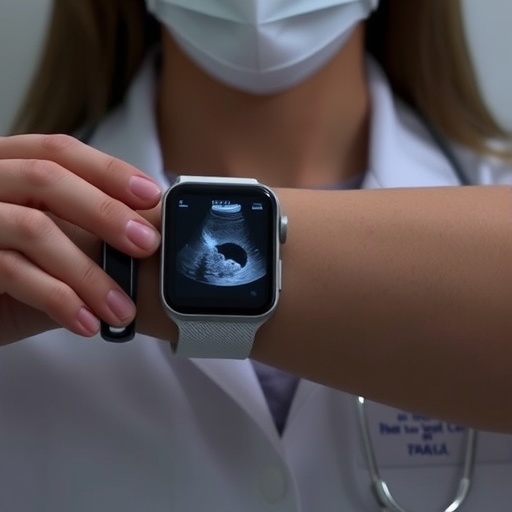Recent advancements in wearable ultrasound technology have ushered in a new era of non-intrusive medical monitoring. This innovative approach transcends traditional healthcare boundaries, allowing for continuous imaging and assessment of various internal tissue structures without the cumbersome apparatus typically associated with ultrasound procedures. As the healthcare landscape evolves, the significance of wearable ultrasound devices becomes increasingly pronounced, offering a suite of possibilities for both chronic disease management and dynamic healthcare situations such as surgical interventions and emergency response.
Unlike conventional ultrasound machines, which often require trained personnel to operate and involve significant patient coordination, wearable ultrasound technology is designed for seamless integration into the daily lives of individuals. These devices are lightweight, portable, and ergonomically designed to ensure they do not hinder the wearer’s mobility or routine activities. This level of accessibility represents a paradigm shift in medical imaging, transforming the way patients and healthcare professionals interact with diagnostic tools.
The therapeutic potential of wearable ultrasound technology is vast, with implications for various medical fields. For instance, in chronic disease management, continuous monitoring can provide real-time data on the physiological state of patients, leading to more proactive interventions. Wearable devices can track vital parameters, identify patterns of deterioration, and make it possible for clinicians to intervene earlier in the disease process, enhancing patient outcomes significantly.
One of the most compelling aspects of wearable ultrasound technology is its ability to provide data that is both granular and comprehensive. Clinicians can gain insights into the subtle variations in a patient’s physiological state over extended periods, offering a deeper understanding of disease progression that handheld devices cannot match. This capability is particularly crucial in fields where timely intervention is paramount, such as cardiology or oncology, where small changes can have significant consequences if not monitored closely.
The design of wearable ultrasound devices is a complex interplay of material selection, mechanical considerations, and system integration that needs to address both performance and comfort. Advanced materials are being utilized to ensure that these devices are not only lightweight but also capable of providing high-resolution imaging comparable to traditional systems. The incorporation of flexible electronics and miniaturized sensors heralds a new design philosophy focused on patient experience, enabling the devices to contour comfortably to the body’s surfaces.
Moreover, the integration of data analytics and machine learning within these wearable systems enhances the utility of the data collected. By processing vast amounts of real-time data from continuous monitoring, algorithms can identify anomalies and alert both patients and medical professionals to potential health concerns before they escalate. This proactive approach, powered by artificial intelligence, is set to revolutionize patient care, transforming the traditional reactive model of healthcare to a more preventative one.
However, despite the promise of wearable ultrasound technology, several barriers exist that may hinder its widespread adoption. One critical challenge lies in technology transfer, especially in low-resource settings where access to advanced medical devices may be limited. To expand the use of wearable ultrasound devices in these regions, a thorough understanding of local healthcare needs and infrastructural capabilities is essential. Developing robust partnerships between technology developers and healthcare providers can facilitate the necessary adaptation of these devices to meet specific community needs.
Additionally, there are significant engineering and clinical challenges that must be addressed to advance wearable ultrasound technology further. These include enhancing the accuracy and reliability of imaging in diverse physiological conditions and environments. Achieving stable and clear ultrasound images from devices that can be worn continuously requires innovative solutions in signal processing and sensor design. Addressing these technical hurdles is critical for ensuring that portable ultrasound devices are widely seen as a credible alternative to traditional systems.
Furthermore, regulatory approvals represent another layer of complexity. The pathway to getting wearable ultrasound devices validated and approved for medical use can be lengthy and complex, often delaying their introduction into the healthcare market. It is vital that stakeholders engage with regulatory bodies early in the design process to ensure compliance with safety and effectiveness standards.
As the field of wearable ultrasound technology continues to mature, it is poised to play an integral role in personalized medicine. The capability to monitor patient health continuously and gather significant amounts of data will enable tailored treatment plans that cater specifically to individual patient needs. For physicians, this represents a golden opportunity to refine practices based on the intricate data patterns generated by these devices, improving clinical decision-making.
In summary, wearable ultrasound technology stands at the intersection of innovation and necessity in modern healthcare. The potential for continuous monitoring, proactive interventions, and enhanced patient-provider engagement heralds a transformative shift in how medical imaging is perceived and utilized. As further advancements are made in materials, design, and data integration, the role of wearable ultrasound devices in preventive health, chronic disease management, and emergency response will undoubtedly expand, paving the way for a more responsive and informed healthcare system.
The journey towards the widespread adoption of wearable ultrasound technology is filled with opportunities and challenges. Collaborations between engineers, clinicians, and stakeholders will be crucial in overcoming these hurdles. As this technology continues to evolve, the vision of making ultrasound monitoring as pervasive and accessible as wearable fitness trackers may soon become a reality.
Collectively, the dialogue surrounding wearable ultrasound technology reflects broader trends in healthcare towards innovation, patient-centeredness, and the embrace of new technologies that enhance the quality and efficiency of medical care. The future will undoubtedly see stakeholders leveraging these advancements, ensuring that both patients and practitioners benefit from more integrated and intelligent healthcare systems.
Subject of Research: Wearable ultrasound technology and its applications in modern medicine.
Article Title: Wearable ultrasound technology.
Article References:
Zhou, S., Park, G., Lin, M. et al. Wearable ultrasound technology.
Nat Rev Bioeng (2025). https://doi.org/10.1038/s44222-025-00329-y
Image Credits: AI Generated
DOI: 10.1038/s44222-025-00329-y
Keywords: ultrasound, wearable technology, healthcare innovation, continuous monitoring, chronic disease management, engineering challenges, data analytics, patient-centered care.




